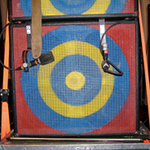Nicolas Touron
The Kingdom
Virgil de Voldère Gallery
526 West 26th Street, Room 416, New York, NY
April 1–May 8, 2010
Nicolas Touron is a storyteller, and like a gifted one of the oral tradition, he enhances and embellishes his tales each time they’re told. As an artist he creates engaging and complex work in both painting and sculpture that, through concepts of movement, evolution, characters, and motifs, suggest larger narratives. Departing from traditional approaches, Touron’s stories never have specific beginnings or ending, and in this way become visual embodiments of the living process of storytelling.
Touron’s third exhibition at Virgil de Voldère Gallery includes a series of paintings of oil marker and pen on wood, called The Kingdom. The primary work, though, is Le Fou, a sculptural object that looks like a biologist’s lab table crossed with an outdoor rotisserie cooker. It’s actually a fully functioning kaleidoscope, and to create these vibrant, fascinating images Touron arbitrarily places things like tiny plants in front of plastic fans—as well as paper cut outs, prints, and ceramic doorknobs (created and fired by the artist, with his own drawings fused onto their surfaces)—in front of an apparatus of mirrors and a camera for projection onto the gallery wall. These rather ordinary items make for a unique, powerful, even transformative experience, and the kaleidoscope becomes a metaphor for the complexities of storytelling, the images shifting and evolving as visual equivalents of spoken words.
Echoing the shape of the kaleidoscope, Touron’s paintings are circular and looping in their own way. The tondo format he employs dissolves the traditional figure-ground relationship, presenting a dizzyingly complex scene that, like singular animated cells of a longer narrative, insists on and eventually rewards extended viewing. The shape of the paintings also recalls similar devices, such as the microscope, telescope, and periscope. Are we looking at an infinitesimal world at the molecular level, or life on some kind of distant globe?
Characters and objects reappear from past works, such as fragmented tree trunks and waddles of green penguins, which are joined by gray airborne vehicles and military helicopters. Other familiar tropes are recognizable: gummy pinks and gooey greens; fluttering ribbons and flying sheets of paper; oozing, doughy creatures and puffy organic growths. In all the commotion, it’s hard to believe the paintings are fixed, static.
The paintings’ titles indicate characters in a king’s court, and black-and-white patterned Islamic tiles emerge in all the works. Are these benign references to history and culture, or darker allusions to domination or imperialism? In the past Touron has played with politics in his work, and, while less rife here, those ideas stealthily and ambiguously creep in. In the recent past, critics have noticed hints of fairy tales in his paintings, but these new works demonstrate a commitment to telling the story of his own distinct universe.
